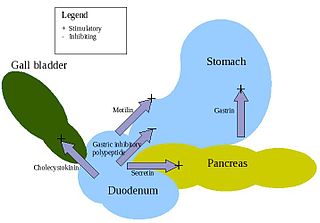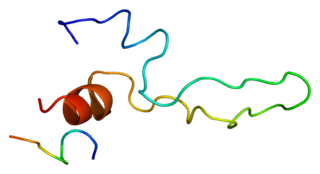Related Research Articles

Cholecystokinin is a peptide hormone of the gastrointestinal system responsible for stimulating the digestion of fat and protein. Cholecystokinin, formerly called pancreozymin, is synthesized and secreted by enteroendocrine cells in the duodenum, the first segment of the small intestine. Its presence causes the release of digestive enzymes and bile from the pancreas and gallbladder, respectively, and also acts as a hunger suppressant.

Gastrin is a peptide hormone that stimulates secretion of gastric acid (HCl) by the parietal cells of the stomach and aids in gastric motility. It is released by G cells in the pyloric antrum of the stomach, duodenum, and the pancreas.
Bombesin is a 14-amino acid peptide originally isolated from the skin of the European fire-bellied toad by Vittorio Erspamer et al. and named after its source. It has two known homologs in mammals called neuromedin B and gastrin-releasing peptide. It stimulates gastrin release from G cells. It activates three different G-protein-coupled receptors known as BBR1, -2, and -3. It also activates these receptors in the brain. Together with cholecystokinin, it is the second major source of negative feedback signals that stop eating behaviour.
In biochemistry, an orphan receptor is a protein that has a similar structure to other identified receptors but whose endogenous ligand has not yet been identified. If a ligand for an orphan receptor is later discovered, the receptor is referred to as an "adopted orphan". Conversely, the term orphan ligand refers to a biological ligand whose cognate receptor has not yet been identified.

H2 receptors are positively coupled to adenylate cyclase via Gs alpha subunit. It is a potent stimulant of cAMP production, which leads to activation of protein kinase A. PKA functions to phosphorylate certain proteins, affecting their activity. The drug betazole is an example of a histamine H2 receptor agonist.
There are two known receptors for the vasoactive intestinal peptide (VIP) termed VPAC1 and VPAC2. These receptors bind both VIP and pituitary adenylate cyclase-activating polypeptide (PACAP) to some degree. Both receptors are members of the 7 transmembrane G protein-coupled receptor family.

Enteroendocrine cells are specialized cells of the gastrointestinal tract and pancreas with endocrine function. They produce gastrointestinal hormones or peptides in response to various stimuli and release them into the bloodstream for systemic effect, diffuse them as local messengers, or transmit them to the enteric nervous system to activate nervous responses. Enteroendocrine cells of the intestine are the most numerous endocrine cells of the body. They constitute an enteric endocrine system as a subset of the endocrine system just as the enteric nervous system is a subset of the nervous system. In a sense they are known to act as chemoreceptors, initiating digestive actions and detecting harmful substances and initiating protective responses. Enteroendocrine cells are located in the stomach, in the intestine and in the pancreas. Microbiota plays key roles in the intestinal immune and metabolic responses in these enteroendocrine cells via their fermentation product, acetate.
Prostaglandin receptors or prostanoid receptors represent a sub-class of cell surface membrane receptors that are regarded as the primary receptors for one or more of the classical, naturally occurring prostanoids viz., prostaglandin D2,, PGE2, PGF2alpha, prostacyclin (PGI2), thromboxane A2 (TXA2), and PGH2. They are named based on the prostanoid to which they preferentially bind and respond, e.g. the receptor responsive to PGI2 at lower concentrations than any other prostanoid is named the Prostacyclin receptor (IP). One exception to this rule is the receptor for thromboxane A2 (TP) which binds and responds to PGH2 and TXA2 equally well.

The gastric inhibitory polypeptide receptor (GIP-R), also known as the glucose-dependent insulinotropic polypeptide receptor, is a protein that in humans is encoded by the GIPR gene. GIP-R is a member of the 7-transmembrane protein family, a class of G protein coupled receptors. GIP-R is found on beta-cells in the pancreas where it serves as the receptor for the hormone Gastric inhibitory polypeptide (GIP).

The neuromedin B receptor (NMBR), now known as BB1 is a G protein-coupled receptor whose endogenous ligand is neuromedin B. In humans, this protein is encoded by the NMBR gene.

The gastrin-releasing peptide receptor (GRPR), now properly known as BB2 is a G protein-coupled receptor whose endogenous ligand is gastrin releasing peptide. In humans it is highly expressed in the pancreas and is also expressed in the stomach, adrenal cortex and brain.

The cholecystokinin B receptor also known as CCKBR or CCK2 is a protein that in humans is encoded by the CCKBR gene.

The Cholecystokinin A receptor is a human protein, also known as CCKAR or CCK1, with CCK1 now being the IUPHAR-recommended name.

Neurotensin receptor type 1 is a protein that in humans is encoded by the NTSR1 gene. For a crystal structure of NTS1, see pdb code 4GRV. In addition, high-resolution crystal structures have been determined in complex with the peptide full agonist NTS8-13, the non-peptide full agonist SRI-9829, the partial agonist RTI-3a, and the antagonists / inverse agonists SR48692 and SR142948A, as well as in the ligand-free apo state., see PDB codes 6YVR (NTSR1-H4X:NTS8–13), 6Z4V (NTSR1-H4bmX:NTS8–13), 6Z8N (NTSR1-H4X:SRI-9829), 6ZA8 (NTSR1-H4X:RTI-3a), 6Z4S (NTSR1-H4bmX:SR48692), 6ZIN (NTSR1-H4X:SR48692), 6Z4Q, and 6Z66.
A cholecystokinin receptor antagonist is a specific type of receptor antagonist which blocks the receptor sites for the peptide hormone cholecystokinin (CCK).

Lorglumide (CR-1409) is a drug which inhibits gastrointestinal motility and reduces gastric secretions, acting as a cholecystokinin antagonist, with fairly high selectivity for the CCKA subtype. It has been suggested as a potential treatment for a variety of gastrointestinal problems including stomach ulcers, irritable bowel syndrome, dyspepsia, constipation and pancreatitis, as well as some forms of cancer, but animal and human testing has produced inconsistent results and no clear therapeutic role has been established, although it is widely used in scientific research.

Devazepide is benzodiazepine drug, but with quite different actions from most benzodiazepines, lacking affinity for GABAA receptors and instead acting as an CCKA receptor antagonist. It increases appetite and accelerates gastric emptying, and has been suggested as a potential treatment for a variety of gastrointestinal problems including dyspepsia, gastroparesis and gastric reflux. It is also widely used in scientific research into the CCKA receptor.
B))
The IUPHAR/BPS Guide to PHARMACOLOGY is an open-access website, acting as a portal to information on the biological targets of licensed drugs and other small molecules. The Guide to PHARMACOLOGY is developed as a joint venture between the International Union of Basic and Clinical Pharmacology (IUPHAR) and the British Pharmacological Society (BPS). This replaces and expands upon the original 2009 IUPHAR Database. The Guide to PHARMACOLOGY aims to provide a concise overview of all pharmacological targets, accessible to all members of the scientific and clinical communities and the interested public, with links to details on a selected set of targets. The information featured includes pharmacological data, target, and gene nomenclature, as well as curated chemical information for ligands. Overviews and commentaries on each target family are included, with links to key references.

Neuropeptide W or preprotein L8 is a short human neuropeptide. Neuropeptide W acts as a ligand for two neuropeptide B/W receptors, NPBWR1 and NPBWR2, which are integrated in GPCRs family of alpha-helical transmembrane proteins.
References
- ↑ Noble F, Wank SA, Crawley JN, Bradwejn J, Seroogy KB, Hamon M, Roques BP (December 1999). "International Union of Pharmacology. XXI. Structure, distribution, and functions of cholecystokinin receptors". Pharmacological Reviews. 51 (4): 745–781. PMID 10581329.
- ↑ Dufresne M, Seva C, Fourmy D (July 2006). "Cholecystokinin and gastrin receptors". Physiological Reviews. 86 (3): 805–847. doi:10.1152/physrev.00014.2005. PMID 16816139.
- ↑ Wank SA (April 1998). "G protein-coupled receptors in gastrointestinal physiology. I. CCK receptors: an exemplary family". The American Journal of Physiology. 274 (4 Pt 1): G607–G613. doi:10.1152/ajpgi.1998.274.4.g607. PMID 9575840. S2CID 27674659.
- 1 2 Beinfeld M, Chen Q, Gao F, Liddle RA, Miller LJ, Rehfeld J (2019-09-16). "Cholecystokinin receptors (version 2019.4) in the IUPHAR/BPS Guide to Pharmacology Database". IUPHAR/BPS Guide to Pharmacology CITE. 2019 (4). doi: 10.2218/gtopdb/F15/2019.4 . S2CID 203825385.